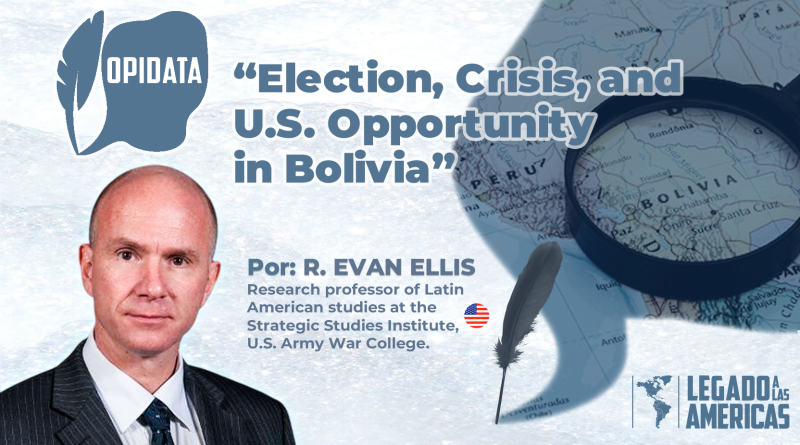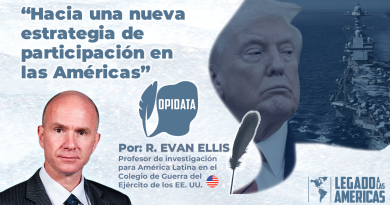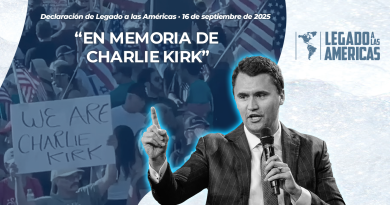Election, Crisis, and U.S. Opportunity in Bolivia
✍️Por R. Evan Ellis[1]
«Bolivia is at an inflection point.»
Introduction
Bolivia, strategically at the center of South America, faces a critical election that will define its direction in its current profound economic, political and security crisis, its future relationship with the People’s Republic of China (PRC), its engagement with the United States and Western institutions, and its role in the Americas and beyond.
Bolivia is at an inflection point. Although it has perennially faced problems, the current reinforcing effects of economic crisis, corruption fueled by criminal economies, and political fragmentation have opened up the possibility of a center-right, pro-US, market oriented government coming to power in the nation’s August 17 national elections. Indeed, the Movement Toward Socialism (MAS) political party that has dominated the country for the past two decades could do so poorly that it might lose its legal standing as a party. At the same time, Bolivia also faces the prospect of expanded political chaos and violence, state capture criminal elements and a resurgent non-democratic left, and a deepened embrace of the PRC and other anti-U.S. actors and policies.
We have been here before, not long ago. In 2019, faced with credible proof that then President Evo Morales attempted to steal an election that would have returned him to office for an unconstitutional fourth time, and fed up with 13 years of MAS corruption and mismanagement, Bolivians took to the streets, obliging Morales’ flight from the country. The actions led to a transitional government that seemed bound to put the country to a more US-friendly, market oriented path. Mistakes by Bolivia’s right, including a poor decision by pro-US transitional President Jeneane Anez to break her prior commitment and run for the Presidency in Bolivia’s 2020 elections, allowed a re-branded MAS, behind the face of seemingly more moderate and technocratic former economy minister Luis Arce, to regain power, ensuring five more years of deepening political, economic, and security challenges.
Roots of Bolivia’s Current Crisis
Bolivia’s current crisis is driven by the interaction of corruption, mismanagement of the country’s oil wealth and other resources by the MAS, and the counterproductive protests and political fights that situation provoked. During its 13 years in power from 2006-2019, the Morales government reaped an economic and political windfall from natural gas production and relatively high prices yet largely squandered the money on programs oriented toward supporters, rather than reinvesting sufficiently to keep oil production up or attract private capital to invest in the industries that would replace it.
By the 2020s, Bolivian gas production, the country’s key generator of foreign currency earnings, was in full decline, while mismanagement, corruption and political chaos slowed the development of the country’s lithium resources and other economic alternatives. The results were predictable, if tragic. As gas production, and the national income it generated in dollars fell, the country’s currency reserves evaporated, compounded by a mix of gasoline subsidies and other bloated state spending commitments. Currency shortages made it increasingly difficult for Bolivian businesspeople to obtain dollars, leading to decreased imports of goods, and fueling inflation. A related scarcity of gasoline impacted food distribution, creating hardships felt on the street. Protests over the shortages and other issues, blocking the very roads used to import and distribute goods, compounded the problem, causing even more shortages and inflation.
Complicating Bolivia’s crisis, the nation’s criminal economy is expanding. That illicit economy is driven in part by cocaine, informal mining, and endemic corruption at all levels of government and society. Although coca production in limited amounts for traditional purposes is legal and regulated in Bolivia, the country has become a major producer of cocaine, as well as a transit country for that produced in neighboring Peru. In 2024, 45.9 metric tons of cocaine were seized by authorities, up 78% from 2023, which was itself a record year. Illustrating the magnitude of the problem, in November 2024, the Bolivian counternarcotics organization FELCN reported its largest ever cocaine seizure, 21 tons of cocaine disguised as flour destined for Hamburg, Germany.
Beyond cocaine, Bolivia’s large and under-controlled informal mining sector, as well as the laundering in Bolivia of illegally mined gold from Peru contributes to the nation’s criminal economy. Illicit activities in Bolivia’s mining sector have reportedly gotten worse with gold prices now at record levels of $3,000 per ounce.
Bolivia has long had problems with corruption and weak institutions and their relationship with the criminal economy. Nonetheless, Bolivia’s ranking of 133 among 180 countries on the Transparency International corruption perception index, a fall of six points in the last decade, highlights the sense among Bolivians that corruption is omnipresent, and only getting worse.
The Infighting in Bolivia’s Left
In the context of such crises and Bolivian disillusionment, bitter political infighting between Bolivia’s prior president, Evo Morales, and its current President Luis Arce, playing out in both its institutions and on the streets, has divided the MAS, Bolivia’s long-dominant leftist party, and deepened popular disillusion with it. In May 2025 decision by Bolivia’s Constitutional Court reaffirmed a prior ruling declaring Morales ineligible to run for re-election as President, leading to violent protests by his followers in June with multiple police deaths.
President Arce, despite his institutional victory over Morales, found himself so profoundly unpopular over his perceived mismanagement of the economy, corruption allegations, and the fight with Morales, that he chose not to run for re-election, leaving his young (36-year old) former Interior Minister, Eduard Castillo, as the standard bearer for the MAS in the Presidential election.
The figure on the left who is arguably Bolivia’s most promising candidate for President is arguably Andronico Rodriguez, former acolyte of Evo Morales, head of his politically important coca producers union, and currently head of the Bolivian senate. Rodriguez, who is alternatively seen as a reformist or a dangerous radical, has been undercut in capturing Morales supporters, insofar as the later has called Rodrigez’s candidacy a “betrayal.”
The Likely Victory of the Political Right
In the context of Bolivian disillusionment with the MAS, the top two candidates in the polls, among the eight running for President, are both from the Bolivian right: multimillionare businessman Samuel Doria Medina, and former President Jorge “Tuto” Quiroga, both receiving approximately 20% among those polled. Former Cochabamba mayor Manfred Reyes Villa, a distant third in the polls with 8% of the intended vote, is also on the political right. The strongest candidate on the left, Andronico Rodriguez, receives a mere 6.5%. The MAS candidate, Eduardo Castillo, receives only 2.3% in the poll. As a caveat, Bolivian polls underestimated the voting intention for the left by an enormous 15 points in the last national election in 2020. Still absent shifts in sentiment, or polling distortions even more radical than in 2020, it appears most likely that Doria Medina and Quiroga will advance to round two of Bolivia’s Presidential election on October 19th effectively locking out the left.
In their policy orientation, Doria Medina and Quiroga, as well as Reyes Villa, generally support Bolivia’s engagement with the International Monetary Fund (IMF), more private-sector friendly economic policies, and seeking better relations with the United States.
In the unlikely, but possible event that Rodriguez surges in the polls, the outcome would be a far more contentious second round on October 19 between Rodriguez and either Doria Medina or Quiroga. This outcome would create the possibility of the Bolivian rallying behind Rodriguez, and possibly even retaining the Presidency.
The outcome of elections for Bolivia’s Congress will also play a defining role in the direction of the country. All 36 seats in Bolivia’s Senate, and all 130 seats in the Chamber of Deputies will be selected on August 17. All seats in the Senate and 60 of 130 seats in the Chamber of Deputies are based on proportional representation. Thus, the distribution of seats among Medina’s Unity Alliance, Quiroga’s Liberty Alliance, Manfred Reyes Villa’s Autonomy for Bolivia party, Andronico Rodriguez’s Popular Alliance, and the MAS will likely reflect the same fragmentation and general favoritism of the right as the candidate’s poll numbers. This represents a dramatic shift from the current situation in which 20 of 36 Senators, and 75 of 130 Deputies belong to the MAS. Whoever is Bolivia’s next President will likely have to form coalitions among multiple Bolivian parties, as occurred in the pre-Morales era, creating the possibility of political paralysis.
The Opportunity for the United States
It is difficult to understate the strategic opportunity that the United States may have with Bolivia’s next government if it can respond with sufficient generosity, nuance, and respect. That new government is likely to be led by right-leaning President and a potentially supportive legislative coalition. Even more importantly, it will be seeking to implement badly needed economic stabilization in the midst of an acute economic and security crisis, and reaching out to the United States and the IMF for help.
The U.S. strategic opportunity in the post-election context includes the possibility of partially displacing Chinese and Russian influence, while gaining improved access to the largest reserve of lithium outside of the PRC. PRC and Russia-based companies currently the major foreign actors in Bolivia’s lithium sector. In addition, the PRC has long played a significant role in providing military equipment to Bolivia, building and operating within its space control facilities, plus being a key player in Bolivia’s telecommunication, construction, power generation, agriculture, and other sectors.
A new center-right government in Bolivia will likely be more open than its predecessor to investment from and work with US-based companies, while limiting engagement with the PRC in sensitive areas. On the other hand, even such a government will need to export to and do business with the PRC, particularly if alternative opportunities from the US and its businesses are not forthcoming.
As occurred following the election of right-oriented governments in Ecuador and Argentina, the new Bolivian government will likely look to Washington for support in negotiating a financial stabilization package from the IMF, as well as expanded security support in the struggle against narcotrafficking and organized crime. The new Bolivian government may also look to the US in combatting corruption and helping to strengthen the nation’s institutions in general.
In the context of the needs of the new Bolivian government and its openness to working ith the U.S., the current U.S. administration may also be able to secure deals for needed investment by its companies for rebuilding Bolivia’s declining petroleum sector, developing its lithium industry, and investing in agriculture, digital industries, and other areas. White House leadership, with support from the Commerce Department and the Development Finance Corporation will be important in securing such wins. Granting Bolivia expanded access to the U.S. market including reduced tariffs could all make a big difference.
The U.S. may also consider how U.S.-friendly Bolivian neighbors Argentina and Paraguay, which already have important business synergies with Bolivia, can be leveraged in creating new economic opportunities for the country, as well as in addressing shared security challenges such as drug transits.
Beyond business and security, Bolivia is also an example of where U.S. funded programs for education, health, democracy and communication can have enormous strategic benefits in building up the country as a strong, stable partner for the U.S. and its companies, while preventing U.S. rivals such as the PRC, Russia, or terrorist and criminal actors, from exploiting the country.
Finally, as Washington thinks about the opportunities presented by the next Bolivian government, and how to interact with it, the U.S. should be sensitive to how perceptions of the relationship within Bolivia might undercut its partner’s position. If Bolivians perceive their next President is too submissive to Washington, or that the country is not treated with respect, it could help the left to rally supporters to paralyze it through strikes, blockades, and legislative resistance.
As during the 2019-2020 transition in Bolivia, the country’s August 17 election present an important opportunity. The U.S. should begin preparing now but also be careful to not overplay its hand.
[1] The author is Latin America Research Professor with the U.S. Army War College. The views expressed herein are strictly his own.
This article is part of Opidata, the editorial platform of Legacy to the Americas for the analysis of key issues in the region.
🔍 More content at 👉 https://legadoalasamericas.org
📩 To receive new articles, subscribe to our newsletter or follow us on social media.




